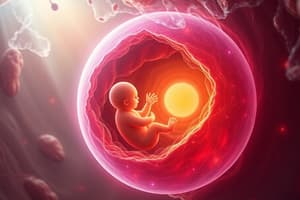Podcast
Questions and Answers
Which English scientist first introduced the concept of tissues in 1665?
Which English scientist first introduced the concept of tissues in 1665?
- Isaac Newton
- Robert Hooke (correct)
- Charles Darwin
- Antonie van Leeuwenhoek
What is the role of nervous tissues in the body?
What is the role of nervous tissues in the body?
- Transmit information through the nervous system (correct)
- Provide structure and support in skeletal muscles
- Support the digestive system
- Absorb water and nutrients from the ground
Which type of tissue contracts to produce movement and maintain posture?
Which type of tissue contracts to produce movement and maintain posture?
- Nervous tissues
- Epithelial tissues
- Connective tissues
- Muscle tissues (correct)
How do tissues develop from embryonic cells?
How do tissues develop from embryonic cells?
What is the main function of connective tissues?
What is the main function of connective tissues?
Why are tissues considered the fundamental building blocks of life?
Why are tissues considered the fundamental building blocks of life?
Which scientist observed the structure of Spirogyra algae, contributing to the understanding of tissues?
Which scientist observed the structure of Spirogyra algae, contributing to the understanding of tissues?
What is the main function of epithelial tissues?
What is the main function of epithelial tissues?
Why are scientists exploring hierarchical modularity to explain biological intelligence?
Why are scientists exploring hierarchical modularity to explain biological intelligence?
What is developmental biology focused on studying?
What is developmental biology focused on studying?
Study Notes
Discovering the World of Tissues: A Journey through Biology
Tissues are the complex, interconnected webs that form the foundation of life as we know it. From the beating hearts in our chests to the luscious leaves of a plant, tissues are the building blocks that make up organs and systems, creating a world of biological wonders.
Origins of Tissue Discovery
The concept of tissues was first introduced by the English scientist Robert Hooke in 1665, when he described cells as the fundamental units of living organisms. The idea of tissues as distinct layers of cells came later, with Antonie van Leeuwenhoek, who observed the structure of Spirogyra algae, laying the groundwork for cell theory. The study of tissues has since grown into a cornerstone of modern biology, spurring discoveries in topics ranging from developmental biology to evolutionary theory.
Types of Tissues
Tissues are categorized into four main types depending on their structure and function:
-
Epithelial tissues: These tissues cover the body's external and internal surfaces and provide a protective barrier. Examples include the skin and the lining of organs like the stomach and blood vessels.
-
Connective tissues: These tissues provide support, structure, and flexibility, as well as a medium for the exchange of nutrients and waste products. Examples include adipose tissue (fat), bone, and blood.
-
Muscle tissues: These tissues contract to produce movement, maintain posture, and generate heat. Examples include skeletal muscle, cardiac muscle, and smooth muscle.
-
Nervous tissues: These tissues transmit information through the nervous system. Examples include neurons and the specialized cells that support them.
Tissue Organization
Tissues are organized into organs, which are further organized into systems that work together to maintain the body's homeostasis and carry out its functions. For instance, the nervous system is made up of the brain and the spinal cord, while the digestive system is made up of organs like the stomach and the intestines.
Development of Tissues
Tissues develop from embryonic cells that go through a process called embryonic induction. This process involves the exchange of signaling molecules between cells, which directs cell differentiation and tissue organization. The study of tissue development, known as developmental biology, has provided valuable insights into the origins of complex structures and their role in evolution.
Tissues and Evolution
Tissues are a crucial part of evolution. As organisms have adapted to their environments, their tissues have evolved to meet the demands of their lifestyles. For example, the evolution of vascular plants led to the development of complex root and leaf tissues that allow them to absorb water and nutrients from the ground.
Intelligence and Tissues
The emergence of intelligent behavior in living systems remains a fundamental mystery in biology. Understanding the origin of intelligence requires examining the mechanisms of tissues and their interactions, from single cells to complex systems like the brain and nervous system. Scientists are currently exploring the idea of hierarchical modularity to explain biological intelligence, which suggests that complex behaviors emerge from the interactions of simple, modular units.
In summary, tissues are the fundamental building blocks of life, providing structure, support, and function in all living organisms. The study of tissues has led to the development of modern biology and continues to be a vital area of scientific discovery. As we delve into the complexities of tissues, we uncover new mysteries and deeper understanding of our world.
Studying That Suits You
Use AI to generate personalized quizzes and flashcards to suit your learning preferences.
Description
Dive into the fascinating world of tissues with this quiz that covers the origins, types, organization, development, and evolution of tissues. Test your knowledge on how tissues form organs and systems, their role in evolution, and their connection to intelligence in living organisms.



